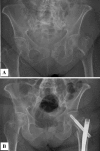Do concomitant fractures with hip fractures influence complication rate and functional outcome?
- PMID: 22707068
- PMCID: PMC3492635
- DOI: 10.1007/s11999-012-2419-z
Do concomitant fractures with hip fractures influence complication rate and functional outcome?
Abstract
Background: Owing to the aging population, the incidence of hip fractures is increasing. While concomitant fractures are not uncommon, it is unclear how they influence subsequent function.
Questions/purposes: Therefore, we determined (1) the incidence, type and treatment of concomitant fractures accompanying hip fractures, (2) the length of hospital stay, (3) the impact of concomitant fractures on mortality and complication rate, and (4) patients' function.
Methods: We retrospectively reviewed 402 patients older than 60 years with hip fractures. We recorded the presence of concomitant fractures and their treatment. We analyzed the duration of hospital stays, in-hospital mortality, perioperative complications, and function. We recorded function with the Barthel Index, Harris hip score, and timed up and go test. For this study we followed patients 1 year.
Results: Twenty-two patients (5%) had concomitant fractures, the most frequent being proximal humeral fractures (n = 8) and distal radius fractures (n = 6). Patients without and with concomitant fractures had similar lengths of hospitalization (mean, 14 days; 95% CI, 13-15 days), in-hospital mortality (5% with concomitant fractures, 6% without concomitant fractures), and incidence of complications (41% versus 40%). Function at discharge and last followup were similar in both groups.
Conclusion: The most frequent concomitant fractures were typical osteoporotic fractures (radial and humeral fractures). Concomitant fractures did not influence length of hospitalization, in-hospital mortality, complication rate, and function. Hip fracture and comorbidities predicted the incidence of complications and patients' function.
Level of evidence: Level II, prognostic study. See the Guidelines for Authors for a complete description of levels of evidence.
Figures





References
-
- American Society of Anesthesiologists. ASA physical status classification system. Available at: http://www.asahq.org/clinical/physicalstatus.htm. Accessed May 2, 2012.
MeSH terms
LinkOut - more resources
Full Text Sources
Medical
Research Materials

